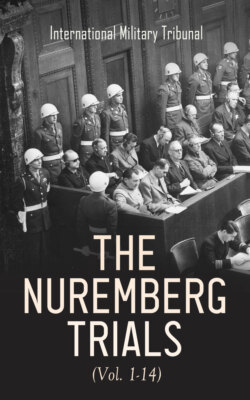Читать книгу The Nuremberg Trials (Vol. 1-14) - International Military Tribunal - Страница 146
The Aggressive War against the Union of
Soviet Socialist Republics
ОглавлениеOn 23 August 1939 Germany signed the non-aggression pact with the Union of Soviet Socialist Republics.
The evidence has shown unmistakably that the Soviet Union on their part conformed to the terms of this pact; indeed the German Government itself had been assured of this by the highest German sources. Thus, the German Ambassador in Moscow informed his Government that the Soviet Union would go to war only if attacked by Germany, and this statement is recorded in the German War Diary under the date of 6 June 1941.
Nevertheless, as early as the late summer of 1940, Germany began to make preparations for an attack on the U.S.S.R., in spite of the non-aggression pact. This operation was secretly planned under the code name “Case Barbarossa”, and the former Field Marshal Paulus testified that on 3 September 1940, when he joined the German General Staff, he continued developing “Case Barbarossa”, which was finally completed at the beginning of November 1940; and that even then, the German General Staff had no information that the Soviet Union was preparing for war.
On 18 December 1940 Hitler issued Directive No. 21, initialed by Keitel and Jodl, which called for the completion of all preparations connected with the realization of “Case Barbarossa” by 15 May 1941. This directive stated:
“The German armed forces must be prepared to crush Soviet Russia in a quick campaign before the end of the war against England . . . . Great caution has to be exercised that the intention of an attack will not be recognized.”
Before the directive of 18 December had been made, the Defendant Göring had informed General Thomas, chief of the Office of War Economy of the OKW, of the plan, and General Thomas made surveys of the economic possibilities of the U.S.S.R., including its raw materials, its power and transport system, and its capacity to produce arms.
In accordance with these surveys, an economic staff for the Eastern territories with many military-economic units (inspectorates, commandos, groups) was created under the supervision of the Defendant Göring. In conjunction with the military command, these units were to achieve the most complete and efficient economic exploitation of the occupied territories in the interest of Germany.
The framework of the future political and economic organization of the occupied territories was designed by the Defendant Rosenberg over a period of three months, after conferences with and assistance by the Defendants, Keitel, Jodl, Raeder, Funk, Göring, Von Ribbentrop, and Frick, or their representatives. It was made the subject of a most detailed report immediately after the invasion.
These plans outlined the destruction of the Soviet Union as an independent State, and its partition, the creation of so-called Reich Commissariats, and the conversion of Estonia, Latvia, Bielorussia, and other territories into German colonies.
At the same time Germany drew Hungary, Rumania, and Finland into the war against the U.S.S.R. In December 1940 Hungary agreed to participate on the promise of Germany that she should have certain territories at the expense of Yugoslavia.
In May 1941 a final agreement was concluded with Antonescu, the Prime Minister of Rumania, regarding the attack on the U.S.S.R., in which Germany promised to Rumania, Bessarabia, Northern Bukovina, and the right to occupy Soviet territory up to the Dnieper.
On 22 June 1941, without any declaration of war, Germany invaded Soviet territory in accordance with the plans so long made.
The evidence which has been given before this Tribunal proves that Germany had the design carefully thought out, to crush the U.S.S.R. as a political and military power, so that Germany might expand to the east according to her own desire. In Mein Kampf, Hitler had written: “If new territory were to be acquired in Europe, it must have been mainly at Russia’s cost, and once again the new German Empire should have set out on its march along the same road as was formerly trodden by the Teutonic Knights, this time to acquire soil for the German plough by means of the German sword and thus provide the Nation with its daily bread.” But there was a more immediate purpose, and in one of the memoranda of the OKW, that immediate purpose was stated to be to feed the German Armies from Soviet territory in the third year of the war, even if “as a result many millions of people will be starved to death if we take out of the country the things necessary for us.”
The final aims of the attack on the Soviet Union were formulated at a conference with Hitler on 16 July 1941, in which the Defendants Göring, Keitel, Rosenberg, and Bormann participated:
